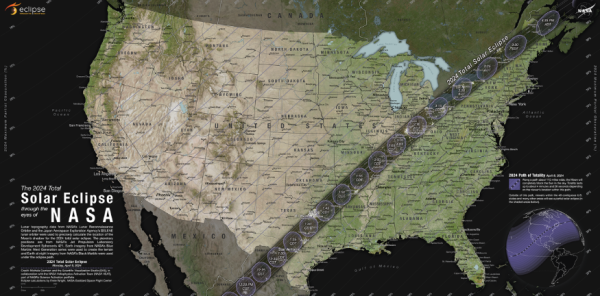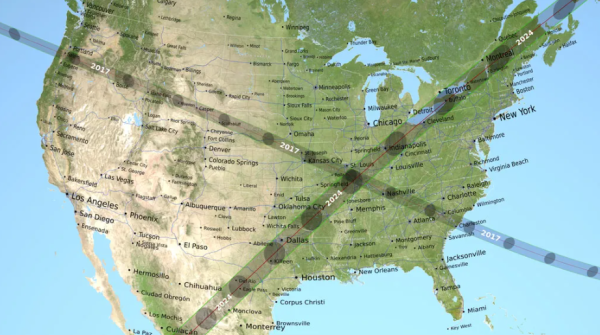What is a Total Solar Eclipse?
A solar eclipse occurs when the moon passes between the sun and the earth, completely blocking the face of the sun. The sky will darken as if it were nighttime. Locations where the moon’s shadow completely covers the sun, known as the path of totality, will experience a total solar eclipse. People along the path of totality will see the Sun’s corona, or outer ring, which is usually obscured by the bright face of the Sun.
When and Where will people see the eclipse?
To see all stages of a total solar eclipse, people must view it from somewhere along the path of totality, which are the locations on Earth where the Moon’s shadow completely covers the Sun. The path of totality for the upcoming total solar eclipse is shown in dark gray in the below. Observers viewing the eclipse from outside the path of totality may observe a partial eclipse, where the Moon covers most

of the Sun, but not all. Eclipse glasses are required for the entire duration of the eclipse when viewing from outside the path of totality. 99% of people who reside in the United States will be able to see the partial or total eclipse from where they live. Every U.S. state, plus parts of Alaska and Hawaii, will experience at least a partial solar eclipse. In Clinton, the partial eclipse will be visible starting at 2:13 PM and ending at 4:37 PM. The maximum view can be seen at 3:27 PM.
Why are eclipse glasses needed?
Viewing any part of the bright Sun through a camera lens, binoculars, or a telescope without a special solar filter will instantly cause severe eye injury. When watching the partial phases of the eclipse, which occur before and after totality, observers must look through safe solar viewing glasses or a safe hand held solar viewer. Safe solar viewing glasses can be purchased from places like Amazon, Target, Walmart, or Home Depot. Additionally, some town libraries will be giving away free pairs.
How is this different from the 2017 eclipse?
The path of totality, where viewers can see the Moon totally block the Sun, is much wider during the upcoming total solar eclipse than it was during the eclipse in 2017. During the 2017 total solar eclipse, the sun was a little but further away from earth than it will be during the upcoming eclipse, casing the path of that eclipse to be skinnier. In 2017, the path was about 62 to 71 miles wide. In 2024, the path of totality will range from 108 to 122 miles wide, meaning the eclipse covers more ground. The 2024 eclipse will also pass over more cities and densely populated areas than the 2017 path did. This will make it easier

for more people to see totality, when the moon fully blocks the sun and the outer corona of the sun is visible. An estimated 31.6 million live in the path of totality this year, compared to 12 million people living in the path of totality in 2017. An additional 150 million people live within 200 miles of the path of totality. In April, totality will last longer than it did in 2017. In 2017, the longest period of totality lasted 2 minutes and 42 seconds. For the upcoming eclipse, totality will last up to 4 minutes and 28 seconds. Durations longer than 4 minutes stretch as far north as Indiana. Even as the eclipse exits the U.S. and enters Canada, the eclipse will last up to 3 minutes, 21 seconds.
What are Morgan’s Thoughts?
Mrs. Walston said that in Clinton, we will see a small crescent of the sun. This is because Clinton is close to, but not in, the path of totality. Clinton will see 92% totality, which is a partial eclipse. Although we are not in the path of totality, viewers must still use solar eclipse glasses when looking at the eclipse. Freshman in Mrs. Walston’s Integrated Science class were each given a pair of eclipse glasses. This eclipse is a once in a lifetime experience, as the next total solar eclipse seen from Clinton will be in 2079.
Information gathered from NASA


